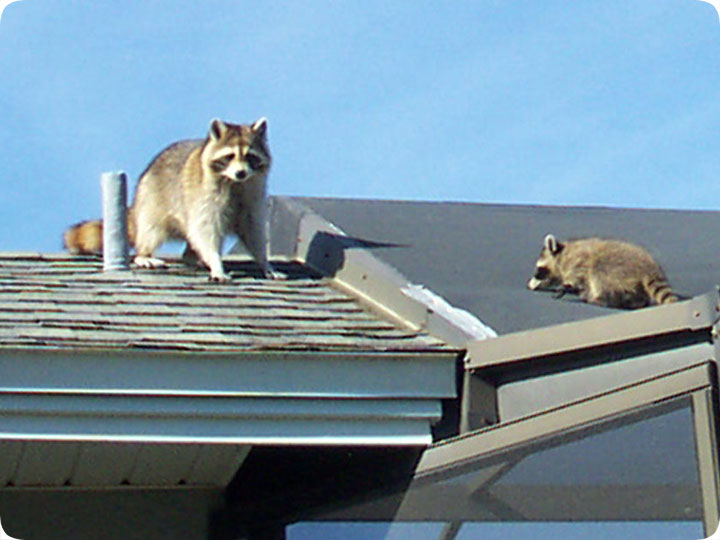-
info@aaanimalcontrol.com
Call us for help in your town
Humane Wildlife Education
Raccoons on the Roof

Most of the times, the reason a racoon is on the roof is because it's torn its way into the attic, and it's en route to its home. That was the case in this photo. I was at this house today because the homeowners have been hearing a lot of noise in the attic. They thought that perhaps the noise was on the roof, but it's hard for the sound to translate through on most architecture. The raccoons happened to be outside when I arrived, and the mother raccoon was taking its ten-week-old young out for an exploratory walk. I took the above photo as the mother raccoon anxiously awaited its baby to reach her. They eventually disappeared.
I inspected the roof, and sure enough, I found that she'd torn a hole in one of the eaves and was going into the attic. I went inside the attic and found the nest of young. She took off while I removed the three young raccoons. I then out them in a special holding cage in the back of a trap and set it on the roof. I sat at a far distance on another portion of the roof and watched as the babies cried for their mother. Sure enough, she came out. After a long time of apprehension and sniffing the outside of the trap, she went in to try to get her young, and I caught her.
I removed them all off the roof, fixed the entry hole, and drove off to relocate them far away. The job was finished in one trip!
Do it yourself: Visit my How To Get Rid of Raccoons page for tips and advice.
Get professional help: Visit my Nationwide Pro Directory of wildlife removal experts.
The raccoon (Procyon lotor), is a unique animal native to North America. It's not closely related to any other animals, with distant relatives such as bears and weasels. Coons are easy to recognize, with a black mask and ringed tail. Raccoons tend to weigh between 10-20 pounds as adults. They are mostly nocturnal, and are omnivores. Racoons average a lifespan of about 5 years in the wild, and have a litter of 3-6 young each spring. They are very strong, excellent climbers, very intelligent, and they are very skilled with their hands. Raccoons have learned to thrive in urban areas, and live in very high densities in cities, where they eat garbage and pet food. They commonly break into homes and attics, where they cause considerable damage, and they also destroy other property, and thus racoons are considered pest animals by many people. Raccoon control and removal, especially from inside homes, is best left to a professional.
For more wildlife stories, click my Wildlife Blog or click my below banner to hire a local trapper.





















